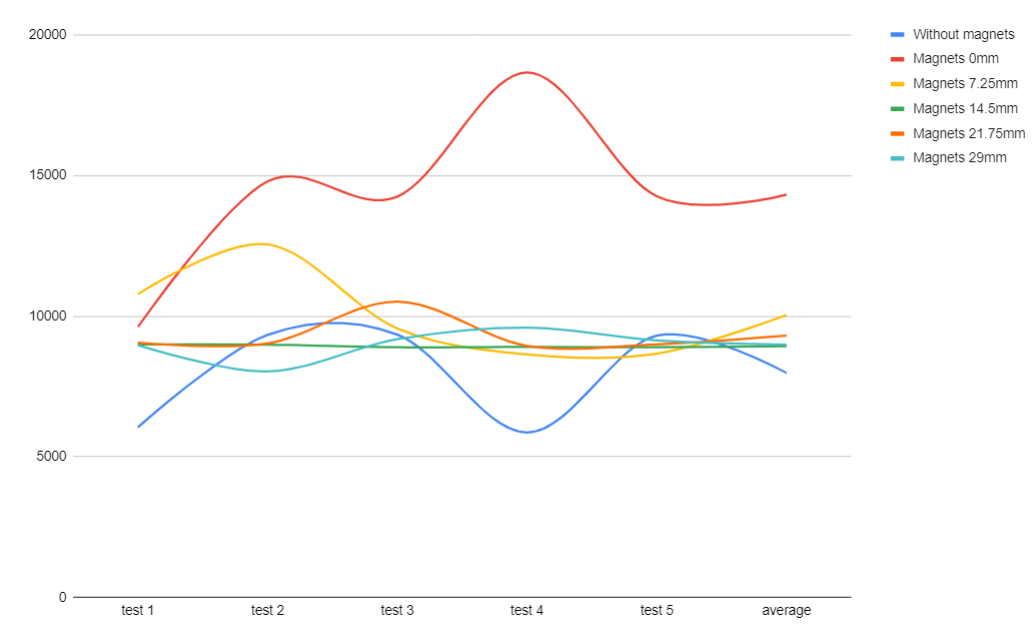Improving the Electrical Motor with Magnets
Grade 8
Presentation
Hypothesis
If two high strength neyodymium magnets are placed on either side of a DC motor, then its revolutions per minute (RPM) will increase due to the extra force pulling the motor around.
Research
- Jared Owen, "How Does an Electric Motor Work? (DC Motor)," https://www.youtube.com/watch?v=CWulQ1ZSE3c.
- David MacAulay, The Way Things Work, Revised Edition (Clarion Books, 2023).
- Science Max, "Electromagnet," https://www.youtube.com/watch?v=vaPfo2hwDSI.
Variables
INDEPENDANT:
- distance of magnets from motor
DEPENTANT:
- RPM of motor
CONTROL:
- RPM of motor without magnets
CONSTANTS:
- same motor
- same magnets
- same batteries
- same setup
Procedure
1. First we will use a 3D printed jig to mount the magnets on both sides of the motor. This will keep them at a set distance during the test.
2. Then we will power the motor with 8 AA batteries to provide 12V of current to the motor.
3. Then we will use a tachometer with a 5cm diameter attachment on the motor shaft to test the RPM.
4. Finally, we will repeat steps 2 and 3 with the magnets at five separate distances. We will start at 0mm from the motor and incrementally increase the distance by 7.25mm for each test. We will repeat each test five times.
Observations
- The motor shook around quite a bit; next time we will hold it in place with a jig.
- We will also add a jig for holding the tachometer (tool for measuring RPM) at a fixed distance to prevent shaking.
- We will use a proper power supply to ensure battery drain does not affect the results.
Analysis
Control: Without the magnets, the average speed of our motor was 7 981 RPM.
Distance 1: With the magnets adjacent to the motor (0mm), the average speed almost doubled to 14 310 RPM.
Distance 2: At a distance of 7.25mm, the average speed slowed to 10 038 RPM (while still exceeding the control).
Distance 3: At a distance of 14.55mm, the average speed slowed further to 8 935 RPM (still exceeding the control).
Distance 4: At a distance of 21.75, the average speed increased slightly beyond distance 3 to 10 038 RPM. This was an unespected result which requires further testing to ensure the accuracy of our results.
Distance 5: At a distance of 29mm, the average speed slowed to 8 983 RPM. Still, we note that the average speed still exceeds our initial control test.
| Without magnets | Magnets 0mm | Magnets 7.25mm | Magnets 14.5mm | Magnets 21.75mm | Magnets 29mm | |
| Test 1 | 6 053.8 RPM |
9 614 RPM |
10 782 RPM | 8 995.5 RPM | 9 058 RPM | 8 969.7 RPM |
| Test 2 | 9 335 RPM | 14 785 RPM | 12 549 RPM | 8 985.7 RPM | 9 031.8 RPM | 8 033.8 RPM |
|
Test 3 |
9 343 RPM | 14 243 RPM | 9 562.3 RPM | 8 893.9 RPM | 10 515 RPM | 9 181.4 RPM |
| Test 4 | 5 868 RPM | 18 654 RPM | 8 636.7 RPM | 8 906.5 RPM | 8 944.1 RPM | 9 591 RPM |
| Test 5 | 9 307 RPM | 14 255 RPM | 8 663.8 RPM | 8 897 RPM | 8 996.8 RPM | 9 139.6 RPM |
| Average | 7 981.36 RPM | 14 310.20 RPM | 10 038.76 RPM | 8 935.72 RPM | 9 309.14 RPM | 8 983.10 RPM |

Conclusion
We conclude that by placing magnets next to an electric motor, the RPM of the motor increase. We moreover conclude that the closer the magnets are to the motor, the greater the RPM (with one exception, which requires further testing).
Our experiment was thus successful in proving our hypothesis.
Application
When magnets are placed next to a motor, the RPM are increased without any extra power input.
This conclusion could have applications for engineering electric motors. In particular, we would propose innovations using external magnets that would increase the RPM. In designing these motors it will be especially important to reduce the distance between the motor and the external magnets.
We live in a time in which new innovations in energy efficiency are increasingly vital. And so, as Aesop put it, "Necessity is the mother of invention."
Sources Of Error
- battery power loss over time
- motor speed when starting and stopping
- motor shaking
- next time measure the torque as well as the RPM
Citations
- Jared Owen, "How Does an Electric Motor Work? (DC Motor)," https://www.youtube.com/watch?v=CWulQ1ZSE3c.
- David MacAulay, The Way Things Work, Revised Edition (Clarion Books, 2023).
- Science Max, "Electromagnet," https://www.youtube.com/watch?v=vaPfo2hwDSI.
Acknowledgement
Rowan Scruggs: for doing background research and designing the trifold
Caius Franco: for performing the tests, 3D printing the motor magnet jig, and entering the data
Amber and Mike Franco: for paying for the supplies
Mr. Casidy: for telling us funny jokes when we should have been working
Avery Guy: for acting as the consultant and mentor of our team
Ryan Scruggs: for tirelessly fixing all our typos
Mrs. Bouchard: for letting us tape the batteries together with her tape

